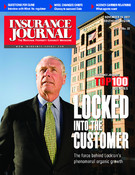Agents might think they have their hands full trying to attract and retain quality employees but they are not alone. Insurance carriers face challenges getting and keeping quality agents, too.
For a company like St. Paul Travelers, which depends on independent agents for 90 percent of its business, the agent is the customer and responding to the customer’s needs and building a lasting relationship with this customer must be taken seriously.
A carrier’s greatest challenge in attracting good agents is being able to set itself apart from the competition beyond the basics, according to William Ryan, senior director of marketing strategy and communications for St. Paul Travelers.
Differentiation can’t always be based on price alone. While that is one basic factor in the equation, Ryan said the quality of relationships, ease of doing business and choosing appropriate markets all play a role in the intermediary determination. “Everyone talks about price, which I see as very funny,” Ryan said. “In insurance we have a lot of differentiation capabilities.”
Ryan spoke on a panel last month in Nashville for a Society of Insurance Research discussion on agency-carrier relations.
It is important for a company to know its agents and to foster relationships with them through close communication, Ryan added.
Also, he maintained, many agents — and their customers — are looking for a brand that has recognition.
A good carrier will supply the tools and training to help agents become partners with added value. “In this commoditized world, it really comes down to ‘what is the role of the agent?'” Ryan said. “Our thought is that they should be consultative — a value-added partner.”
Part of a carrier’s role is to help small to midsize agencies (which comprise most of the market) get comfortable with changing technology, according to Ryan. “It’s a volume business with a lot of flow and customers are looking for convenience — a one-stop-shop approach has a lot of value to many agents,” says Ryan.
An agency’s growth orientation may be subjective, according to Ryan, but carriers look at it closely. They generally avoid agencies that are “just in the harvest mode,” in favor of those who want to grow with them. “If they’re committed to growing, then we’re very focused on them,” he said.
From an agent’s perspective, there are several factors that can influence an agency to pursue a certain carrier, according to Rick Bondurant, director of agency management for the Independent Insurance Agents of Texas.
Agencies are looking for carriers that can keep them gainfully employed in an ever-increasing competitive environment. This means helping to support everything from human resources to management acumen to sophisticated risk management practices.
Agency Life Cycles
Not only must carriers deal with agencies at varying stages in their life cycles, but in a state like Texas, they must also be equipped to operate in a highly diverse geographical region, noted Bondurant.
Bondurant said staffing and recruiting are a new agency’s major challenges and this is one area where a carrier’s expertise and resources can make or break a fledgling operation.
Branding may or not be on an agency’s list of criteria. “Brand identification of a carrier is more important to an agency that hasn’t yet gained a name or reputation in the community,” he added.
As agencies progress through the process of prospecting for customers and gaining access to carriers, they seek increasingly higher level of support to help them grow, achieve economies of scale and secure perpetuation, Bondurant said.
“Members are interested in getting assistance to perpetuate. Carriers can seal a relationship by bringing expertise agencies don’t have: prospect identification; research; customer preferences; recruitment leveraging; and human resources expertise,” Bondurant said.
Agencies look to carriers for management expertise, especially on ways to handle segmentation issues. Agencies are segmenting more between transaction-based customers — those looking for lowest prices who switch agencies very easily — and relationship clients — those who don’t move from company to company over pricing. “The big challenge is how to organize around their customers,” Bondurant said. “We’re also seeing increased segmentation between personal lines, small commercial, large commercial and employee benefits.”
The carrier-agent relationship often teeters on the degree to which a carrier can support the increased segmentation. This may involve looking beyond the current renewal cycle, Bondurant said.
Similarly, in regard to supply chain collaboration, Bondurant said agencies are increasingly looking for ways to escape forced competitive pricing and compete more on an added-value concept. “It’s a question of where you want to be in five years,” he said. “Compete on added value: total cost of risk.”
When it comes to the nuances of agents distinguishing carriers, Bondurant said the ease of doing business is very important. Agents also look at carriers’ total revenue picture and for carriers that have a “broad appetite” – generally avoiding those that cater more to niche markets, he added.
Was this article valuable?
Here are more articles you may enjoy.


 Former CEO of Nonprofit P/C Statistical Agent Sentenced for Stealing Millions
Former CEO of Nonprofit P/C Statistical Agent Sentenced for Stealing Millions  Brown & Brown Files Suit Over Alleged Howden Poaching of 200+ Employees
Brown & Brown Files Suit Over Alleged Howden Poaching of 200+ Employees  Three Top P/C Insurers Account for Most of Insurance AI Patents
Three Top P/C Insurers Account for Most of Insurance AI Patents  Cloudy Future for Bourbon Has Jim Beam Closing Distillery for a Year
Cloudy Future for Bourbon Has Jim Beam Closing Distillery for a Year 


